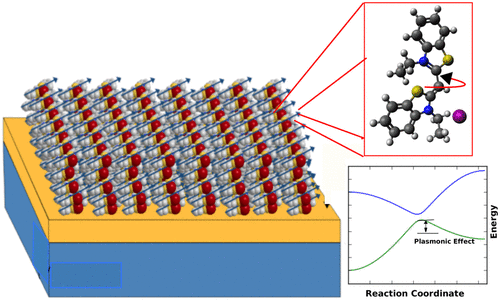当前位置:
X-MOL 学术
›
ACS Photonics
›
论文详情
Our official English website, www.x-mol.net, welcomes your
feedback! (Note: you will need to create a separate account there.)
Can Ultrastrong Coupling Change Ground-State Chemical Reactions?
ACS Photonics ( IF 6.5 ) Pub Date : 2017-11-20 00:00:00 , DOI: 10.1021/acsphotonics.7b00610 Luis A. Martínez-Martínez 1 , Raphael F. Ribeiro 1 , Jorge Campos-González-Angulo 1 , Joel Yuen-Zhou 1
ACS Photonics ( IF 6.5 ) Pub Date : 2017-11-20 00:00:00 , DOI: 10.1021/acsphotonics.7b00610 Luis A. Martínez-Martínez 1 , Raphael F. Ribeiro 1 , Jorge Campos-González-Angulo 1 , Joel Yuen-Zhou 1
Affiliation

|
Recent advancements on the fabrication of organic micro- and nanostructures have permitted the strong collective light–matter coupling regime to be reached with molecular materials. Pioneering works in this direction have shown the effects of this regime in the excited state reactivity of molecular systems and at the same time have opened up the question of whether it is possible to introduce any modifications in the electronic ground energy landscape which could affect chemical thermodynamics and/or kinetics. In this work, we use a model system of many molecules coupled to a surface-plasmon field to gain insight on the key parameters which govern the modifications of the ground-state potential energy surface. Our findings confirm that the energetic changes per molecule are determined by effects that are essentially on the order of single-molecule light–matter couplings, in contrast with those of the electronically excited states, for which energetic corrections are of a collective nature. Hence the prospects of ultrastrong coupling to change ground-state chemical reactions for the parameters studied in this model are limited. Still, we reveal some intriguing quantum-coherent effects associated with pathways of concerted reactions, where two or more molecules undergo reactions simultaneously and which can be of relevance in low-barrier reactions. Finally, we also explore modifications to nonadiabatic dynamics and conclude that, for our particular model, the presence of a large number of dark states yields negligible effects. Our study reveals new possibilities as well as limitations for the emerging field of polariton chemistry.
中文翻译:

超强偶联可以改变基态化学反应吗?
有机微结构和纳米结构的制造方面的最新进展使得分子材料可以实现强大的集体光-质耦合机制。在这个方向上的开创性工作已经表明了该机制对分子系统的激发态反应性的影响,同时也提出了一个问题,即是否有可能在电子地面能态中引入任何可能影响化学热力学的修饰。和/或动力学。在这项工作中,我们使用包含耦合到表面等离子体场的许多分子的模型系统来了解控制基态势能表面修饰的关键参数。我们的发现证实,与电子激发态具有集体校正性质的电子激发态相反,每个分子的能量变化基本上取决于单分子光-物质耦合的量级。因此,在该模型中研究的参数用于改变基态化学反应的超强耦合的前景是有限的。仍然,我们揭示了与协同反应的途径相关的一些有趣的量子相干效应,其中两个或多个分子同时经历反应,并且在低势垒反应中可能具有相关性。最后,我们还探索了对非绝热动力学的修改,并得出结论,对于我们的特定模型,大量黑暗状态的存在产生的影响可忽略不计。
更新日期:2017-11-21
中文翻译:

超强偶联可以改变基态化学反应吗?
有机微结构和纳米结构的制造方面的最新进展使得分子材料可以实现强大的集体光-质耦合机制。在这个方向上的开创性工作已经表明了该机制对分子系统的激发态反应性的影响,同时也提出了一个问题,即是否有可能在电子地面能态中引入任何可能影响化学热力学的修饰。和/或动力学。在这项工作中,我们使用包含耦合到表面等离子体场的许多分子的模型系统来了解控制基态势能表面修饰的关键参数。我们的发现证实,与电子激发态具有集体校正性质的电子激发态相反,每个分子的能量变化基本上取决于单分子光-物质耦合的量级。因此,在该模型中研究的参数用于改变基态化学反应的超强耦合的前景是有限的。仍然,我们揭示了与协同反应的途径相关的一些有趣的量子相干效应,其中两个或多个分子同时经历反应,并且在低势垒反应中可能具有相关性。最后,我们还探索了对非绝热动力学的修改,并得出结论,对于我们的特定模型,大量黑暗状态的存在产生的影响可忽略不计。











































 京公网安备 11010802027423号
京公网安备 11010802027423号